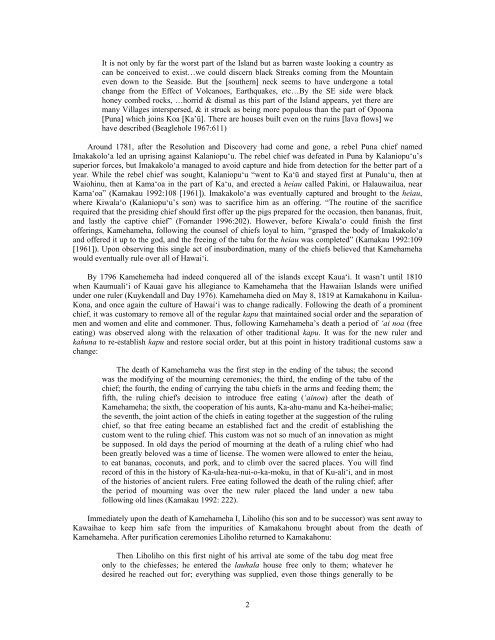Honu'apo Park Resource Management Plan
Honu'apo Park Resource Management Plan
Honu'apo Park Resource Management Plan
Create successful ePaper yourself
Turn your PDF publications into a flip-book with our unique Google optimized e-Paper software.
It is not only by far the worst part of the Island but as barren waste looking a country as<br />
can be conceived to exist…we could discern black Streaks coming from the Mountain<br />
even down to the Seaside. But the [southern] neck seems to have undergone a total<br />
change from the Effect of Volcanoes, Earthquakes, etc…By the SE side were black<br />
honey combed rocks, …horrid & dismal as this part of the Island appears, yet there are<br />
many Villages interspersed, & it struck as being more populous than the part of Opoona<br />
[Puna] which joins Koa [Ka‛ū]. There are houses built even on the ruins [lava flows] we<br />
have described (Beaglehole 1967:611)<br />
Around 1781, after the Resolution and Discovery had come and gone, a rebel Puna chief named<br />
Imakakolo‘a led an uprising against Kalaniopu‘u. The rebel chief was defeated in Puna by Kalaniopu‘u’s<br />
superior forces, but Imakakolo‘a managed to avoid capture and hide from detection for the better part of a<br />
year. While the rebel chief was sought, Kalaniopu‘u “went to Ka‘ū and stayed first at Punalu‘u, then at<br />
Waiohinu, then at Kama‘oa in the part of Ka‘u, and erected a heiau called Pakini, or Halauwailua, near<br />
Kama‘oa” (Kamakau 1992:108 [1961]). Imakakolo‘a was eventually captured and brought to the heiau,<br />
where Kiwala‘o (Kalaniopu‘u’s son) was to sacrifice him as an offering. “The routine of the sacrifice<br />
required that the presiding chief should first offer up the pigs prepared for the occasion, then bananas, fruit,<br />
and lastly the captive chief” (Fornander 1996:202). However, before Kiwala‘o could finish the first<br />
offerings, Kamehameha, following the counsel of chiefs loyal to him, “grasped the body of Imakakolo‘a<br />
and offered it up to the god, and the freeing of the tabu for the heiau was completed” (Kamakau 1992:109<br />
[1961]). Upon observing this single act of insubordination, many of the chiefs believed that Kamehameha<br />
would eventually rule over all of Hawai‘i.<br />
By 1796 Kamehemeha had indeed conquered all of the islands except Kaua‘i. It wasn’t until 1810<br />
when Kaumuali‘i of Kauai gave his allegiance to Kamehameha that the Hawaiian Islands were unified<br />
under one ruler (Kuykendall and Day 1976). Kamehameha died on May 8, 1819 at Kamakahonu in Kailua-<br />
Kona, and once again the culture of Hawai‘i was to change radically. Following the death of a prominent<br />
chief, it was customary to remove all of the regular kapu that maintained social order and the separation of<br />
men and women and elite and commoner. Thus, following Kamehameha’s death a period of ‘ai noa (free<br />
eating) was observed along with the relaxation of other traditional kapu. It was for the new ruler and<br />
kahuna to re-establish kapu and restore social order, but at this point in history traditional customs saw a<br />
change:<br />
The death of Kamehameha was the first step in the ending of the tabus; the second<br />
was the modifying of the mourning ceremonies; the third, the ending of the tabu of the<br />
chief; the fourth, the ending of carrying the tabu chiefs in the arms and feeding them; the<br />
fifth, the ruling chief's decision to introduce free eating (‘ainoa) after the death of<br />
Kamehameha; the sixth, the cooperation of his aunts, Ka-ahu-manu and Ka-heihei-malie;<br />
the seventh, the joint action of the chiefs in eating together at the suggestion of the ruling<br />
chief, so that free eating became an established fact and the credit of establishing the<br />
custom went to the ruling chief. This custom was not so much of an innovation as might<br />
be supposed. In old days the period of mourning at the death of a ruling chief who had<br />
been greatly beloved was a time of license. The women were allowed to enter the heiau,<br />
to eat bananas, coconuts, and pork, and to climb over the sacred places. You will find<br />
record of this in the history of Ka-ula-hea-nui-o-ka-moku, in that of Ku-ali‘i, and in most<br />
of the histories of ancient rulers. Free eating followed the death of the ruling chief; after<br />
the period of mourning was over the new ruler placed the land under a new tabu<br />
following old lines (Kamakau 1992: 222).<br />
Immediately upon the death of Kamehameha I, Liholiho (his son and to be successor) was sent away to<br />
Kawaihae to keep him safe from the impurities of Kamakahonu brought about from the death of<br />
Kamehameha. After purification ceremonies Liholiho returned to Kamakahonu:<br />
Then Liholiho on this first night of his arrival ate some of the tabu dog meat free<br />
only to the chiefesses; he entered the lauhala house free only to them; whatever he<br />
desired he reached out for; everything was supplied, even those things generally to be<br />
2


